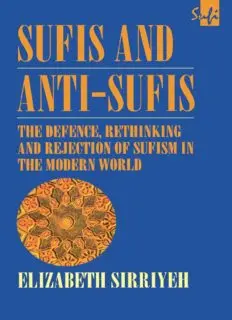
Sufis and Anti-Sufis: The Defence, Rethinking and Rejection of Sufism in the Modern World PDF
Preview Sufis and Anti-Sufis: The Defence, Rethinking and Rejection of Sufism in the Modern World
Sufis and Anti-Sufis CURZON SUFI SERIES Series editor: Ian Richard Netton Professor of Arabic and Middle Eastern Studies, University of Leeds The Curzon Sufi Series attempts to provide short introductions to a variety of facets of the subject, which are accessible both to the general reader and the student and scholar in the field. Each book will be either a synthesis of existing knowledge or a distinct contribution to, and extension of, knowledge of the particular topic. The two major underlying principles of the Series are sound scholarship and readability. BEYOND FAITH AND INFIDELITY The Sufi Poetry and Teachings of Mahmud Shabistari Leonard Lewisohn AL-HALLAJ Herbert W Mason RUZBIHAN BAQLI Mysticism and the Rhetoric of Sainthood in Persian Sufism Carl W Ernst ABDULLAH ANSARI OF HERAT An Early Sufi Master A.G. Ravan Farhadi THE CONCEPT OF SAINTHOOD IN EARLY ISLAMIC MYSTICISM Bernd Radtke and John O'Kane SUHRAWARDI AND THE SCHOOL OF ILLUMINATION Mehdi Amin Razavi PERSIAN SUFI POETRY An Introduction to the Mystical Use of Classical Persian Poems ]. T. P de Bruijn AZIZ NASAFI Lloyd Ridgeon Sufis and Anti-Sufis The Defence, Rethinking and Rejection of Sufism in the Modern World Elizabeth Sirriyeh ~l Routledge !;i ~ Taylor & Francis Group LONDON AND NEW YORK First Published in 1999 by Curzon Press Published 2013 by Routledge 2 Park Square, Milton Park, Abingdon, axon OX14 4RN 7111hirdAvenue, New York, NY, 10017, USA Routledge is an imprint of the Taylor & Francis Group, an informa business © 1999 Elizabeth Sirriyeh Typeset in Horley Old Style by LaserScript Ltd, Mitcham All rights reserved. No part of this book may be reprinted or reproduced or utilised in any form or by any electronic, mechanical, or other means, now known or hereafter invented, including photocopying and recording, or in any information storage or retrieval system, without permission in writing from the publishers. British Library Cataloguing in Publication Data A catalogue record for this book is available from the British Library Library of Congress Cataloguing in Publication Data A catalogue record for this book has been requested ISBN 13: 978-0-700-71060-7 (pbk) For my mother, Grace This page intentionally left blank Contents Preface lX Abbreviations Xlll 1 Sufis and Their Critics Before the Impact of Europe 1 The Mood of Decline 2 Sufi Reformers: Shah Waif Allah and A~mad b. Idrfs 4 The Spirit of Mass Reform Within the Tarfqas 11 Rejection of the Tarfqas: the Arabian Wahhabfs 22 2 The Challenge of European Anti-Sufism 27 The Lesser Jihad 29 The Greater Jihad and Worldly Constraints 43 3 Traditional Sufism or a Religion of Progress? 54 Sufism and European Thought in the Nineteenth Century 54 Early Islamic Modernism and Sufism 59 Sufi Orders and the Ottoman Version of Pan-Islamic Regeneration 74 4 The Sufism and Anti-Sufism of the Salafis 86 Mu~ammad cAbduh (1849-1905), Sufi and Anti-Sufi 86 Mu~ammad Rashfd Ri4a, Anti-Sufi (1865-1935) 98 The Salafiyya in the Arab Lands 102 5 Strengthening the Soul of the Nation 112 Ziya Gokalp (1876-1924) 112 Mu~ammad Iqbal (1876?-1938) 124 Vll SUFIS AND ANTI-SUFIS 6 Contemporary Sufism and Anti-Sufism 140 Sufi Tarfqas, 1950s-1960s: Decline and Continuity 140 The Tarfqas and the Contemporary Islamic Revival 145 State Anti-Sufism 153 Radical Rethinking of the Way 161 Conclusion: Many Ways Towards the One 173 Bibliography 176 Index 183 Vlll Preface Opposition to Sufism is not essentially a modern phenomenon. It has been evidenced through much of Islamic history, reaching a notorious early culmination in the brutal torture and execution of al-I:Iallaj, ecstatic martyr of divine love, in 922 C.E. However, some of the harshest criticism has traditionally come from within the ranks of the Sufis, as witnessed in the famous comment recorded by Rozbihan BaqlI (d. 1209): 'I looked into Hell, and I saw that most of its inhabitants were those donning a patched frock and carrying a food- bowl. ,1 The most distinguished of medieval critics, Ibn Taymiyya (d. 1328), who mayor may not have been a Sufi himself, provided an important source of authority for many later reformers, whether Sufi leaders intent on ensuring their followers' conformity with the Holy Law or resolute rejecters of Sufism. 2 Yet while these currents of dissatisfaction with Sufism had long been present in the umma, they were to grow substantially from the middle of the eighteenth century, giving rise to a greater variety of self-questioning among Muslims as well as attacks from outside the Islamic world. This book attempts to explore some of the ways in which Sufism has been challenged over the last two centuries by the forces of anti-Sufism, understood at times as opposition to Sufism in all its aspects, at times as criticism of certain Sufi beliefs and practices regarded as unacceptable innovations with no authentic basis in Qur'an and Sunna and no laudable purpose. Many studies of Islam in the modern period have been concerned with the attempts of Muslim 'modernists', and more recently 'fundamentalists', to come to terms with Western modernity and, in the process, traditional Sufis have often appeared to be sidelined or placed in a separate compartment. It is often remarked how many of the so-called modernists or fundamentalists were at some time in their lives Sufis or at least had Sufi contacts in their upbringing. This is hardly surprising in view of the fact that the Sufi tarfqas so permeated IX
